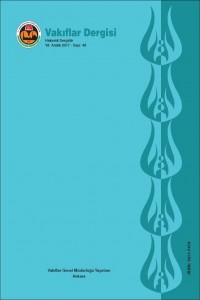Abstract
Tarihi dönemler içerisinde Merzifon ve yöresi önemli yerleşim alanları olarak dikkat çekmektedir. Bu bölgede yerleşimin artması ile birlikte, şehircilik hareketlerinde hızlanma görülmüş ve farklı medeniyetler tarafından birçok farklı eser inşa edilmiştir. Son olarak Osmanlı hakimiyeti yıllarında Merzifon’da, medrese ve külliye tipi yapılarla birlikte daha çok cami ve mescid türünde yapılar ortaya çıkmıştır. Bu çalışmada, bu yapı tiplerinden birisi olan Alaca Minare Mescidi yapısal performansının belirlenmesi amacı ile detaylı incelemeye tabi tutulmuştur. Mescidin üç boyutlu modeli, bilgisayar ortamında oluşturulmuş, daha sonra bu model statik ve deprem analizlerini içeren dinamik analizlere tabi tutulmuştur. Yapılan bu analizlerle, yapının boyut yeterliliği ve deprem etkisi altındaki yapısal performansı tespit edilmeye çalışılmıştır. Elde edilen bu bilgilere bağlı olarak, caminin olası deprem etkisinde zorlanabilecek ve hasara uğrayabilecek bölümleri ile ilgili bir fikir verilmek amaçlanmıştır. Çalışmada, hasara uğraması muhtemel bu bölgelerin, uygun tekniklerle restorasyonun yapılması gerektiği önerilmiştir.
References
- ANSYS (2014). Finite Element Analysis Program. USA
- Çerkez, Murat (2005). Merzifon’da Türk Devri Mimari Eserleri. Ankara Üniversitesi Sosyal Bilimler Enstitüsü Basılmamış Doktora Tezi, Ankara.
- Çerkez, Murat (2007). Merzifon Alaca Minare Mescidi. Dini Araştırmalar Dergisi, C.10: s. 28. Ankara.
- Taşan, A. Aziz (1979). Dün’den-Bugüne Merzifon. Merzifonlular Yardımlaşma Derneği Yay. İstanbul.
Abstract
Merzifon and its region are attracting notice as important residential areas during historical periods. With the increase of the settlement in this region, acceleration in movement of urban has occured and many different structures have been built by different civilizations. Finally at Merzifon Ottoman dominance years, not only the madrasas and complex, but also little or big mosques have emerged. In this study, one of these called Alaca Minaret Mosque has been subjected to detailed examination in order to determine its structural performance. Three-dimensional model of the mosque was built on a computer, then this model has been subjected to static and dynamic analysis which includes seismic analysies. With these analysies, it was aimed to determine the size adequacy and structural performance of the mosque under earthquake effect. Depending on the information obtained, it is intended to give an idea about the parts that can be damaged under the effect of a possible earthquake. Also in this study, restoration of mosque parts which can subject to possible damage during an earthquake, with appropriate techniques of restoration was proposed.
References
- ANSYS (2014). Finite Element Analysis Program. USA
- Çerkez, Murat (2005). Merzifon’da Türk Devri Mimari Eserleri. Ankara Üniversitesi Sosyal Bilimler Enstitüsü Basılmamış Doktora Tezi, Ankara.
- Çerkez, Murat (2007). Merzifon Alaca Minare Mescidi. Dini Araştırmalar Dergisi, C.10: s. 28. Ankara.
- Taşan, A. Aziz (1979). Dün’den-Bugüne Merzifon. Merzifonlular Yardımlaşma Derneği Yay. İstanbul.
Details
| Journal Section | Articles |
|---|---|
| Authors | |
| Publication Date | December 30, 2017 |
| Submission Date | February 7, 2017 |
| Acceptance Date | September 22, 2017 |
| Published in Issue | Year 2017 Issue: 48 |
The articles sent to the Journal of Waqfs with a request for publication are subject to preliminary examination by the Editorial Board and at least two academicians who are experts in their fields are sent for review. The copyright of the articles accepted to be published in the Journal of Waqfs with the referee reports and the decision of the Editorial Board is deemed to have been transferred to the General Directorate of Foundations, and a royalty fee is paid to the published articles in accordance with the relevant legislation.


